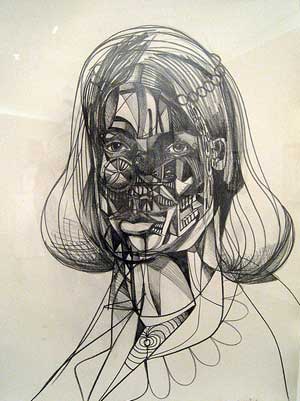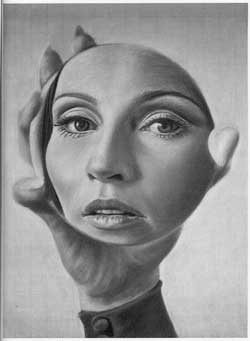
Face to Face at the Denver Arts Museum: Portraits Up Close
It is no coincidence that Richard Phillips “Mirror,” a 1998 charcoal and chalk on paper drawing from the Kent and Vicki Logan collection, is the drawing hung beneath the title of the exhibit: Face | Face (the second Face is flipped horizontally appearing backwards as if seen in a mirror). The portrait is of a hand holding a mirror and reflected in that round mirror is the face of a voluptuous woman. This exhibit was designed to illustrate the evolution of portrait drawing, but not in a linear sense, instead the salon style hanging of 17 of the 35 works presents portraiture from a less structured, less formal point a view, a more circular and interactive view, rather than the rigid sequential perspective some critics and historians espouse. Face to Face is strongest in contemporary, post-modernist portraiture and primarily features works from the 20th Century. However, “Portrait of a Woman Wearing a Hennin,” ink and chalk on paper from 1500 by Bernardo Buotalenti and “The Grotto of Pan,” watercolor and ink on paper from 1856 by Richard Dadd are examples of classic portraiture that wasnt. These are not drawings with coded symbolism about the subjects status, virtue or worthy attributes. They are more contemporary than old. All are works in which the artist has a direct communication with the viewer and the viewer has a direct way of approaching the model or sitter.

Art historians and critics have filled books and magazines on the theories behind portraiture in an attempt to define this complex, yet compelling art form that has survived centuries, and remains fresh and new even in todays cynical art world. Perhaps China Chow did oversimplify portraiture in the first episode of Bravos Work of Art when she proclaimed “a successful portrait is one that shows a viewer the inner essence of your subject.” Yet, I do not believe her comment warranted the response it got from LA Times art critic Christopher Knight who lamented that after 50 years of “marvelous, disruptive paintings and photographs…were still trotting out the wheezing cliche about portraitures required significance being bound up with the revelation of the sitters inner essence? Really? The 17th century lives on.”
Why yes, Mr. Knight, the 17th century lives on, and so does the 16th in this exhibit at the Denver Art Museum. In fact, more than 500 years of portrait drawing are shown in 35 works brought together from various private collections in Colorado and museum holdings. Knight might also lament the wall text that accompanies Face to Face.
“Whereas the earlier drawings show portraits with an eye for correctness of physical appearance, later twentieth-century examples allow a looser, more relaxed approach with an interest in a psychological portrait as well as a physical representation. …Among other things, in these drawings there is anger, joy, mystery, sensuousness, and love.”
For Christoph Heinrich, Face to Face has to do with the aspect of portraiture that goes beyond what is seen. “The artist knows more about the person than they can show with the features of the person. A big draw and a big excitement is to go beyond the visible,” he said. “Many of these artists have deconstructed ways to show more.”
George Condos “Constructed Female Portrait,” uses geometry and scaffolding to construct the face of art collector Vicki Logan. This clearly goes beyond just drawing her features or capturing her likeness as a photographer would. Similarly, Chuck Closes “Phil” an ink on paper from 1973 shows a grid over a realistic drawing, a prelude to his current painting style. Close has taken some liberties in his drawing, there is some handwriting shown that reveals more of a process and an emotional connection. It is one of the things Heinrich enjoys about drawing and works on paper. “There is so much information in them, you see something different, a detail you havent seen before, each time you look at the work.” For me, both of these works explore the fragments of personal identity and all the multiple things that make up on individual.
The back wall of the odd shaped gallery features works that are disturbing, dark, sad, melancholic, and soulful including two portraits by Marlene Dumas: “Bad Mouth,” mixed media on paper, 1996 a plum colored face with thick black eyes and textured crusty lips and “Erika,” ink and acrylic on paper, 1998, a full frontal nude with eyes that draw the viewer back again and again. Thomas Schütte: “Big Head (Grosser Kopf)” ink on paper, 1992, a yellow head against a black background, the subject drawn with fine lines shares the wall with Dumas. Perpendicular to them are works by Francesco Clemente, “Self-Portrait with Lemon Heart,” an oddly tinted watercolor on paper, 2005 and Lucian Freud, also a “Self-Portrait,” darkly shadowed watercolor and graphite on paper 1961.

Bill Amundson, 'Self-Portrait with Pricey Mountain Homes,' 2009, pencil on paper, 40 x 44'.
On a pedestal in front of the Dumas is Robert Crumbs “Portrait of Jackie and Ari,” an ink on paper drawn tabloid cover from 1960. Across the room, Philip Gustons “Untitled” ink on sheetrock from 1970 its cone-headed figures pointing at each other with large hands, one holding a cigar and Bill Amundsons “Self-Portrait with Pricey Mountain Homes,” graphite on paper from 2008 his head capped with windmills and Aspen Mc Mansions reflect humor, irony, neurosis and perhaps even a dystopian view of society. Playing with perception.
There are bits of unexpected art history in this exhibit, such as the small drawing of Paul Klee looking over his sons shoulder at what his son is drawing. “Klee was inspired by children and other cultures that at the time were called primitive,” Heinrich reminded. Another work, “The Instant Decorator/Sun Room with Richard and Harley” a mixed media on card by Laurie Simmons from 2001-7 of Harley Baldwin and his companion Richard Edwards is a happy collage of the pair who founded the Baldwin Gallery in Aspen.
Dedicating this third floor gallery in the Hamilton Building to works on paper was an early vision of Christoph Heinrich, then the curator of Modern & Contemporary Art and now the director of the Denver Art Museum. The museum plans to exhibit a continuous program of drawing and Face to Face is the first of these rotations. As for the Phillips drawing, “Mirror” Heinrich says: “It just wraps you. You really cannot get rid of it.”
Hes right. Face to Face is not merely a show about the many ways to draw a face, thats oversimplistic. Its an exhibition of work that challenges identity and representation, filled with the work of subjects portraying subjects with all their fractured and complex elements. By looking at these images we know more about the artist, the subject and ourselves. Or as Heinrich said: “A portrait is always a face with a soul. What makes a face a portrait is the intention or wish of the artist to capture some of the soul. The artist is trying to tell us the character and charm of the person.”
(top photo: George Condo, “Constructed Female Portrait”)
